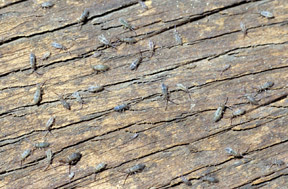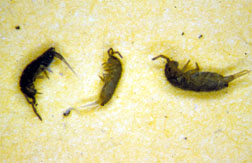by W. Cranshaw* (12/12)
Quick Facts…
- Springtails cannot bite and they are harmless to humans and larger animals.
- During hot, dry periods in summer springtails sometimes migrate from lawns and outdoor areas to homes.
- Springtails tend to be fairly resistant to most insecticides and migrations can involve continuous movement of new individuals. However, some yard and garden insecticides do make claims of springtail control on the label.
Springtails are minute arthropods that may occur in tremendous numbers in soils, but they are rarely observed. Their activities most commonly come to the attention of humans only when large numbers migrate into homes. Another unusual event involving springtails are their occurrence as ‘snow fleas’ found on the surface of thawing snow.
Appearance

Figure 1. Springtails under a board. |
Springtails are tiny, pinhead-sized arthropods. The most commonly seen species have a somewhat elongated body, but others have a rounded globose body form. Springtail colors vary but most are gray or purplish. Others, are pale colored and most, under microscopic observation, are patterned. The coloration of most Colorado springtails is produced by protective scales that cover the body.
Springtails are wingless and crawl slowly, but have a unique means of locomotion – the “spring tail.” This involves a fork-like structure (furcula) attached to the hind end that can fold under the body. Upon release, the furcula pushes the springtail and allows it to jump short distances. Because of this jumping habit and their small size, springtails are sometimes described as “jumping dirt.” Springtails possess six legs, as do insects. Formerly, they were typically classified as an order of insects. However, they have many features that are not found in insects and are now usually classified as Entognathous Hexapods, a separate sister group from the insects (subclass Insecta). All springtails are classified as being within the order Collembola, with several different springtail families present in Colorado.
Life History and Habit
Habits of the springtails vary. The great majority develop in soil, feeding on fungi, algae, decaying plant matter and bacteria. Some are predators of small soil animals, and a few may damage tender plants. However, none of them can bite and they are harmless to humans and larger animals.
Springtail life cycles are completed rapidly when temperatures allow and springtails may produce periodic population explosions. In moist soils with high amounts of organic matter, tremendous numbers may be present – thousands per square foot. Overcrowding and soil drying may induce migrations. Sometimes springtails may be seen on the surface of puddled water, often in such numbers as to form a large raft of their floating bodies.
Springtails in Homes
During hot, dry periods in summer springtails sometimes migrate from lawns and outdoor areas to homes. This occurs when the soils and leaf litter where they develop dry out, forcing springtails to seek sources of moisture, which shaded, more humid buildings provide. Household migrations of springtails in Colorado typically occur when a period of moist weather in spring – favorable to developing high populations – is followed by sustained hot and drying during early to mid summer.
If springtails can find their way into a building they will usually be found most abundantly in areas where water sources are present, such as bathrooms or kitchen sinks. Outdoors, a faucet or pooled water in a garden is attractive.
Springtails within a home will not bite, feed on household items, nor cause any significant damage. They can be a temporary nuisance, but migrations usually last less than a week and springtails trapped indoors soon die out.
If migrations occur try to eliminate all obvious moisture sources around the building. Alternatively, providing moisture at some point distant from the building may help divert migrations.
The effectiveness of insecticides to manage springtail migrations is questionable. Springtails tend to be fairly resistant to most insecticides and migrations can involve continuous movement of new individuals. However, some yard and garden insecticides do make claims of springtail control on the label.

Figure 2. Springtails. |

Figure 3. Globose springtail. |
Springtails and Houseplants
Springtails occasionally develop in the soil of houseplants. Most often they are noticed just after watering, when they may move temporarily from the saturated soil to the surface.
In houseplant soils springtails are functioning as they do outdoors – scavenging dead plant matter and feeding on soil microorganisms. They do very little, if any, damage to the houseplant. Problems can be limited if the soil is allowed to dry down a bit more between waterings, which discourages high soil moisture that allows them to survive and reproduce well.
The ‘Snow Flea’ Phenomenon
Perhaps the most bizarre springtail behavior that people may observe is when they are seen massing on the surface of thawing snow. This is often described as the “snow flea” phenomenon, since the minute springtails jump as might a tiny flea.
The “snow fleas” are springtails normally found feeding in leaf litter and soil that work their way to the surface of the snow. They crawl up the trunks of trees, plant stems and side of rocks where an open channel allows their migration. Tremendous numbers can sometimes be found on the surface, which superficially looks like dirt. Footprints or other depressions may collect very dense populations.
There are still questions regarding this behavior. It is suggested that migrations are triggered because of overcrowding and lack of food. Springtails may feed on small particles of debris that have collected on the snow surface. Many of the springtails may later work their way back down to the soil through the same type of channels, but many are trapped and will ultimately die.
*W. Cranshaw Colorado State University Extension entomology specialist, and professor, bioagricultural sciences and pest management. 7/07. Revised 12/12.
Colorado State University, U.S. Department of Agriculture, and Colorado counties cooperating. CSU Extension programs are available to all without discrimination. No endorsement of products mentioned is intended nor is criticism implied of products not mentioned.
Go to top of this page.





